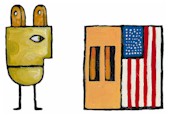
In the age of the Internet, there is no longer an excuse for any legitimate candidate for office, anywhere, to remain unable to communicate his presence and his platform to the electorate.
Space on the Internet is so cheap as to be almost free. All we need are an easily-found site where the full set of candidates for a given office can be “assembled” in the same place, and space for the candidates to state their positions and debate one another on various topics. Let them whale away at the issues (and one another) however they like.
It’s important to have a centralized clearinghouse, rather than just a disorganized scattering of individual candidates’ sites, because looking up candidate sites individually doesn't work for new candidates whose names are unfamiliar to us. Only on a consolidated site will we be capable of finding candidates other than the Name Brands we're already familiar with--and it’s precisely this type of openness to new voices that’s needed to counter the crushing power advantages currently conferred by incumbency and a large media budget.
Fortunately, the League of Women Voters has already made a good deal of progress in creating this type of clearinghouse. In the 2002 elections, the LWV fielded an extensive network of interrelated, state-by-state, issue-by-issue web pages.
What’s needed now are mainly refinements based on what’s been learned from practical experience.
For example, the LWV pages typically provide a summary matrix that attempts to show where all the candidates stand on the various issues that have surfaced in each race. While in theory this could be a useful time saver for voters, in actual practice it doesn’t work quite that way.
A large number of the issues turn out to be so emotionally charged that the candidates are unwilling to reduce their positions to a simple thumbs-up or thumbs-down answer, and choose instead to describe their stands only in lengthier text formats, which can include background, context, persuasive articulations of why they have chosen the side they have, conciliatory language toward those with whom they disagree, and so forth.
Some form of structure still needs to be brought to the proliferation of candidates’ campaign positions. But a more useful way of applying it would be simply to provide the candidates with a consolidated online discussion forum--much like the ones many Internet users already participate in, only with update access limited to the candidates and their staffs.
Here candidates could create and contribute to as many discussion topics as they liked. In the ongoing exchange of claim and counterclaim, assertion and disputation and refutation, voters could find a refreshingly thoroughgoing, rich, and lively exploration of the issues--as well as getting a good sense of what the candidates themselves are like.
In fact, given the ongoing nature and effectively limitless depth of such an online forum, combined with voters’ ability to access it whenever it’s most convenient for them, plus their ability to go directly to the discussion topics that interest them most, this form of political communication could in many ways surpass even the traditional town meetings we tend to feel nostalgic for.
About the only element of the traditional town meeting missing would be an opportunity for citizens to add their own comments to the debate--and this could easily be accommodated, with the simple addition of a section of the forum not limited to just the candidates.
In other words, we now have an opportunity to restore political communication to perhaps the most robust health it has ever known.
We just need to seize the moment, and act.


